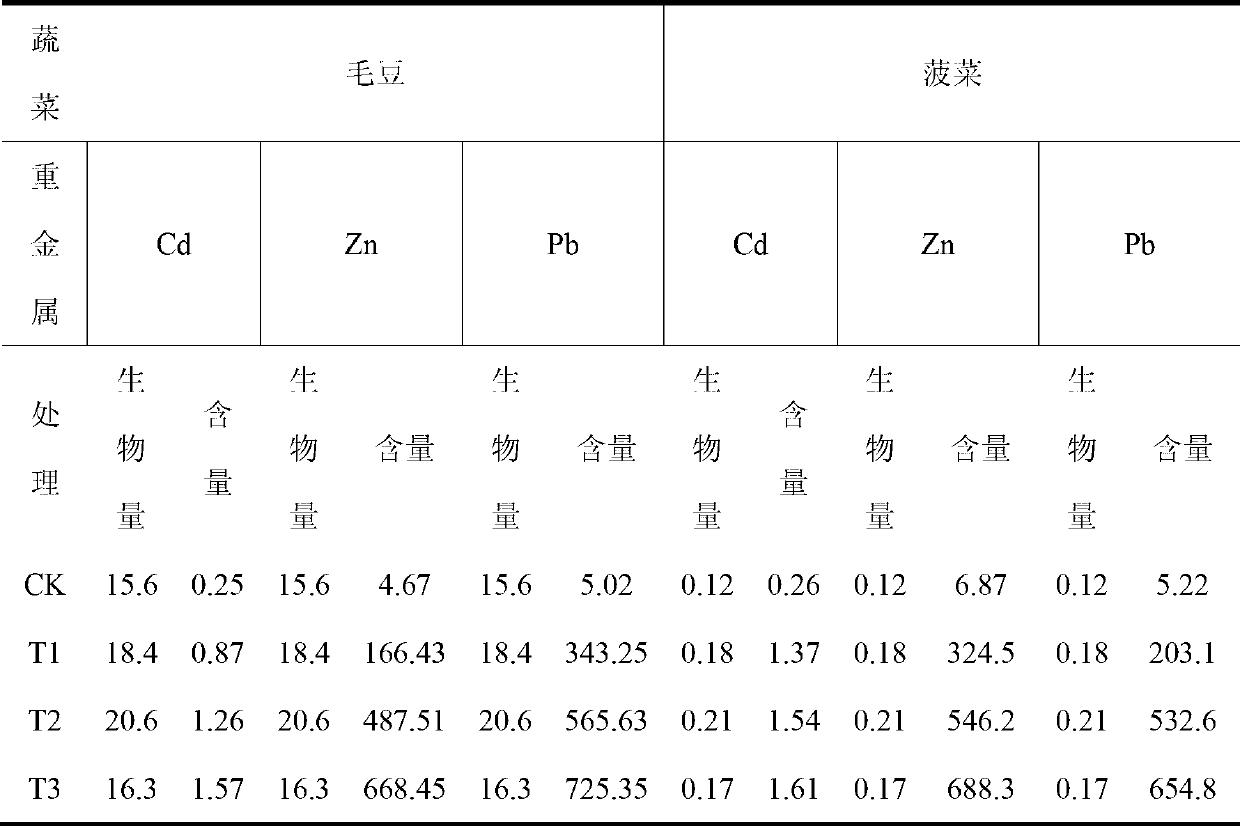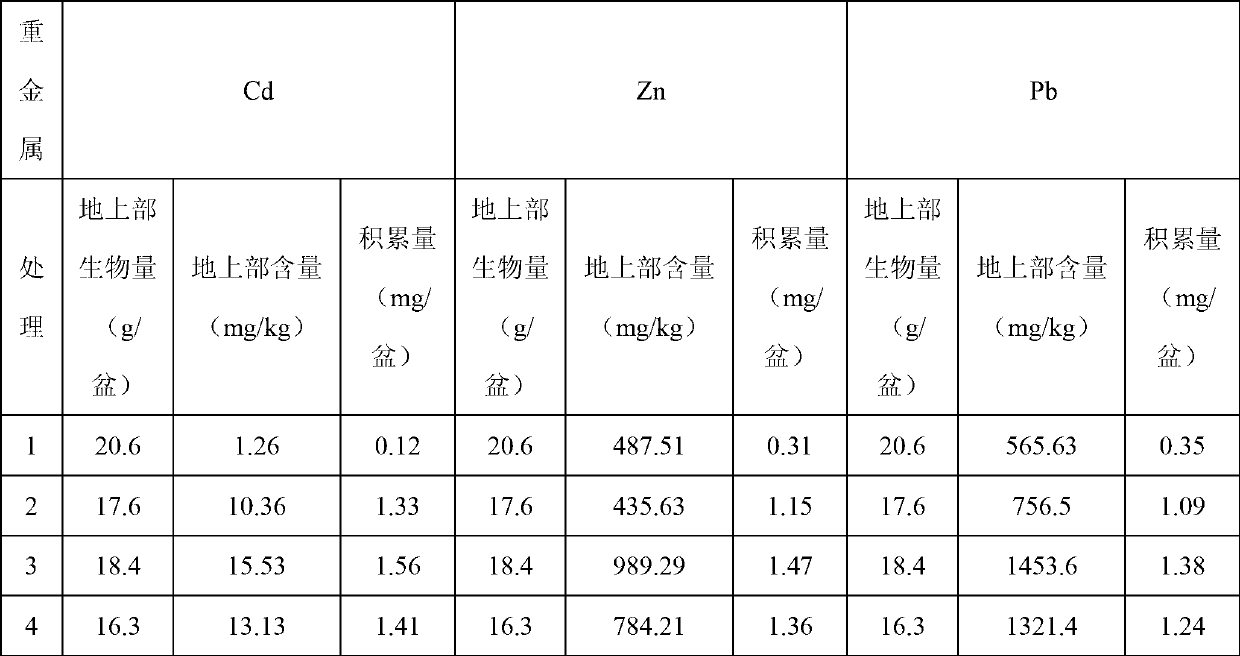Method for assisting vegetable crops to restore Cd-Zn-Pb composite contaminated soil by EDTA (Ethylene Diamine Tetraacetic Acid)
A compound pollution and soil technology, applied in the restoration of polluted soil, etc., can solve the problems of slow growth of enriched plants, low activity of heavy metals, small biomass, etc., to reduce repair costs and environmental risks, low technical requirements, The effect of strong tolerance and enrichment ability
- Summary
- Abstract
- Description
- Claims
- Application Information
AI Technical Summary
Problems solved by technology
Method used
Image
Examples
Embodiment 1
[0014] The pot test site is in the net room of the Rice Research Institute in Wujin District, Changzhou City. The site is in a farm in Wujin District. There are no pollution sources around the experimental site, and it is an area that is not polluted by heavy metals and organic matter. The potting test soil was collected from the surface soil (0-20 cm) in the pollution-free area of the Rice Research Institute in Wujin District, Changzhou City.
[0015] A total of 4 concentrations were set in the experiment, which were the control (CK, no Cd, Zn, Pb) and 3 different Cd, Zn, Pb concentration experiments, Cd concentration: 2.0mg / kg (T1 ), 6.0mg / kg (T2), 10.0mg / kg (T3), Zn concentration: 1000mg / kg (T1), 3000mg / kg (T2), 5000mg / kg (T3), Pb concentration: 1000mg / kg (T1), 3000mg / kg (T2), 5000mg / kg (T3), which are respectively 2, 6, and 10 times of the third-level standard of my country's soil environmental quality standard (GB15618,, 195), and the form of heavy metal added is CdCl 2...
Embodiment 2
[0024] The content of Cd, Zn and Pb added in the soil is 6mg / kg, 3000mg / kg and 3000mg / kg respectively, and the form of heavy metal added is CdCl 2 2.5H 2 O, ZnSO 4 ·7H 2 O, Pb(NO 3 ) 2 , add to the soil, mix well, and balance for half a year before use. Edamame seedlings with the same growth as in Example 1 were selected for transplanting. 2 weeks before the harvest of edamame, EDTA was applied near the root zone of the soil surface, and the artificial chelating agent was added at one time. Each treatment was repeated 3 times, and the edamame was harvested 2 weeks after the treatment. , Plant spinach seedlings in the soil, and the treatment method of spinach is the same as that of edamame. The specific implementation is shown in Table 2.
[0025] The application concentration of table 2 chelating agent EDTA
[0026]
[0027] The experimental results showed (Table 3 and Table 4), that one-time application of chelating agent EDTA 2 weeks before harvest would improve th...
Embodiment 3
[0033] The content of Cd, Zn and Pb added in the soil is 6mg / kg, 3000mg / kg and 3000mg / kg respectively, and the form of heavy metal added is CdCl 2 2.5H 2 O, ZnSO 4 ·7H 2 O, Pb(NO 3 ) 2 , add to the soil, mix well, and balance for half a year before use. , select and transplant the edamame seedlings consistent with the growth of Example 1, but the artificial chelating agent EDTA is added in two times, adding by the time described in Table 5, wherein the maturity is two weeks before the harvest, and the specific embodiments are shown in Table 5.
[0034] Table 5 The application order and concentration of EDTA
[0035]
[0036] The experimental results showed (Table 6 and Table 7): EDTA was applied when it was mature, and EDTA was applied one week before harvest. The accumulation of Cd, Zn, and Pb reached 6.8 times, 3.25 times, and 4.9 times that of the control, respectively.
[0037] Treatment 3 is better than the one-time application of EDTA in Example 2. The divided ...
PUM
 Login to View More
Login to View More Abstract
Description
Claims
Application Information
 Login to View More
Login to View More - R&D
- Intellectual Property
- Life Sciences
- Materials
- Tech Scout
- Unparalleled Data Quality
- Higher Quality Content
- 60% Fewer Hallucinations
Browse by: Latest US Patents, China's latest patents, Technical Efficacy Thesaurus, Application Domain, Technology Topic, Popular Technical Reports.
© 2025 PatSnap. All rights reserved.Legal|Privacy policy|Modern Slavery Act Transparency Statement|Sitemap|About US| Contact US: help@patsnap.com



